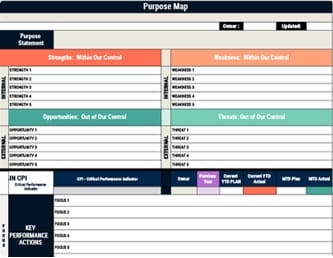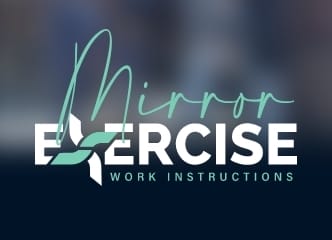You can use a Purpose Map to make every role’s impact visible, linking daily tasks to strategic outcomes so people see why their work matters, how it ladders to goals, and where collaboration reveals results. Start by clarifying objectives, mapping responsibilities to metrics, and identifying handoffs, then show the cause‑and‑effect path from actions to outcomes. As you align roles, coach managers, and equip teams with tools, you’ll uncover gaps and opportunities that change what you do next.
Key Takeaways
- Start with mission and values, then map departments and roles to show how daily work ladders to strategic objectives.
- Define clear responsibilities and KPIs per role, linking tasks to measurable outcomes and deadlines.
- Co-create maps with leaders, managers, and frontline staff through workshops and feedback loops for alignment and buy-in.
- Activate maps via weekly check-ins, coaching, and dashboards that visualize milestones, progress, and cross-team dependencies.
- Measure and iterate quarterly using integrated KPIs, analytics, and employee feedback to refine goals and development plans.
Why a Purpose Map Matters for Culture and Performance
Although a Purpose Map is simple in concept, it’s a powerful tool for shaping culture and driving performance because it makes the connection between daily work and organizational mission explicit.
When you show people how their role advances organizational success, you strengthen employee engagement and build a healthier workplace culture. You also gain transparency by visually mapping contributions, which encourages collaboration across teams and raises productivity as work becomes more coordinated.
Employees who understand their impact are far likelier to focus effort where it matters, which boosts employee performance and reduces friction. Clear purpose supports employee retention, protecting talent continuity and lowering turnover costs.
When people see their impact, performance rises, friction falls, and retention strengthens.
Because people can see why their work matters, they’re more motivated, more consistent, and more accountable for results.
Building Your Purpose Map: Core Elements and Workflow
A practical Purpose Map starts with clear structure and a disciplined workflow, guiding you from organizational intent to individual accountability in a way people can see and act on.
Begin by listing organizational objectives and company values, then map departments and employee roles beneath them to establish alignment. For each role, define responsibilities and key performance indicators that express measurable impact, using simple metrics tied to outcomes you already track.
Build the workflow by gathering input from leaders, managers, and front-line staff, consolidating insights into a single visual that shows employee contributions clearly.
Facilitate employee engagement through workshops and brief drafts, capturing what success looks like for each role. Add feedback loops with regular reviews, update objectives and KPIs as priorities shift, and publish revisions so everyone stays current and accountable.
Connecting Roles to Strategy: From Daily Tasks to Outcomes
With your Purpose Map structure in place, turn the blueprint into action by linking each role’s daily tasks to the strategic outcomes you’ve defined, so people can see how their work moves company goals.
Map responsibilities to measurable results within your organizational strategy, then clarify expectations by stating which activities drive which outcomes and why they matter.
Translate projects into specific employee contributions, such as metrics, deadlines, and quality standards, to strengthen employee engagement and employee motivation.
Use performance management systems for real-time tracking of progress against strategic outcomes, so you can prioritize work that lifts productivity.
Review task-to-outcome links regularly to catch misalignment early and adjust workload or scope.
Close the loop with timely feedback and recognition that highlights impact, reinforcing focus, building ownership, and sustaining momentum toward shared success.
Activating the Purpose Map: Communication, Coaching, and Tools
Because a Purpose Map only drives results when people use it daily, activate it through clear communication rhythms, targeted coaching, and simple tools that make progress visible.
Start with weekly check-ins that link tasks to organizational goals, using the Purpose Map to clarify priorities, remove blockers, and reinforce accountability. In coaching, review each person’s map, translate needs into development plans, and show how new skills influence outcomes, which builds engagement without guesswork.
Use weekly check-ins and coaching to tie tasks to goals, remove blockers, and build accountable engagement.
Adopt tools like interactive dashboards and performance management software, letting employees see milestones, dependencies, and next actions in real time, which increases transparency and self-direction.
Integrate map metrics into one-on-ones and team huddles so updates become habit. Organizations report higher employee satisfaction and retention when employees can track impact, understand expectations, and align effort to the Purpose Map.
Measuring Impact and Iterating for Continuous Alignment
Once the Purpose Map is in daily use through rhythms, coaching, and tools, you need proof that it’s working and a method to refine it.
Start by defining Key Performance Indicators (KPIs) that tie employee contributions to team and company goals, so you can quantify employee impact with clarity and fairness.
Pair these metrics with feedback mechanisms—quick pulse surveys and structured performance reviews—so you capture perception and evidence.
Use data analytics tools to spot trends, compare cohorts, and surface where resource allocation or development opportunities will reveal results.
Provide personalized dashboards that visualize progress toward objectives, helping employees see their direct impact and adjust quickly.
Close the loop by revisiting goals quarterly, iterating KPIs, and updating coaching plans to maintain continuous alignment.
Frequently Asked Questions
How Do We Budget for Building and Maintaining a Purpose Map?
Budget by splitting costs into one-time build and ongoing run.
Allocate funds for discovery workshops, mapping software or templates, facilitation, and change management, then set a contingency.
For maintenance, budget quarterly updates, ownership time, refresh workshops, training for new hires, and lightweight metrics.
Anchor totals to headcount and complexity, set a 12–18 month horizon, phase deliverables, and require ROI checkpoints tied to engagement, speed-to-alignment, and decision quality improvements.
What Legal or Privacy Risks Exist When Mapping Individual Contributions?
You face privacy, labor, and discrimination risks, since 63% of employees worry about workplace data misuse.
Collect only necessary data, document a lawful basis, and issue clear notices.
Avoid sensitive attributes, apply role-based access, and anonymize or aggregate outputs where feasible.
Secure data with encryption, retention limits, and audit trails.
Obtain consent where required, honor opt-outs, and conduct DPIAs for high-risk processing, aligning practices with GDPR, CCPA, and local employment laws.
How Should Unions or Works Councils Be Involved in the Process?
You should involve unions or works councils from the outset, sharing objectives, data scopes, and decision rights, and securing formal consultation where required.
Co-create transparent criteria for mapping contributions, define acceptable metrics, and agree on data minimization, anonymization, and appeal processes.
Provide impact assessments, timelines, and training plans, and document consent or legitimate interest bases.
Establish a joint governance committee, schedule periodic reviews, and commit to remedying unintended consequences, including bias, workload inflation, or disciplinary misuse.
How Do We Adapt a Purpose Map During Mergers or Reorganizations?
You adapt it by revalidating outcomes, consolidating overlapping goals, and mapping new value streams to the combined structure.
Start with a joint leadership workshop, define the single north star, then cascade measurable outcomes to functions and teams.
Inventory roles, retire duplications, and rewrite contribution links.
Involve managers and employee reps early, run pilots in high-impact units, and iterate monthly using metrics and feedback, ensuring transparency, ownership, and clear change narratives.
What Governance and Ownership Model Keeps the Purpose Map Accurate?
Use a federated model: you own a central steward (PMO or Strategy) for standards, taxonomy, and tooling, while each function appoints a Map Owner for updates and validation.
Establish quarterly refresh cycles, change controls tied to OKR or roadmap gates, and a lightweight RACI clarifying who proposes, approves, and audits changes.
Instrument versioning, metadata, and review checklists, and require evidence—metrics, process links, and roles—before publishing, ensuring accuracy and traceability.
Conclusion
By building and activating a Purpose Map, you make every role’s impact visible, align daily work to strategy, and create a repeatable system for coaching and decisions. Start with clear outcomes, connect tasks to metrics, and review alignment regularly. Communicate progress in plain terms, then adjust workflows as priorities shift. One compelling data point: companies with highly aligned employees are 58% more likely to exceed revenue goals, which underscores why you should measure impact and iterate relentlessly.



